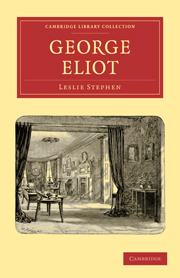Book contents
- Frontmatter
- Contents
- CHAPTER I EARLY LIFE
- CHAPTER II COVENTRY
- CHAPTER III “THE WESTMINSTER REVIEW”
- CHAPTER IV “SCENES OF CLERICAL LIFE”
- CHAPTER V “ADAM BEDE”
- CHAPTER VI “THE MILL ON THE FLOSS”
- CHAPTER VII “SILAS MARNER”
- CHAPTER VIII MIDDLE LIFE
- CHAPTER IX “ROMOLA”
- CHAPTER X “FELIX HOLT”
- CHAPTER XI “THE SPANISH GYPSY”
- CHAPTER XII “MIDDLEMARCH”
- CHAPTER XIII “DANIEL DERONDA”
- CHAPTER XIV CONCLUSION
- INDEX
CHAPTER IV - “SCENES OF CLERICAL LIFE”
Published online by Cambridge University Press: 05 July 2011
- Frontmatter
- Contents
- CHAPTER I EARLY LIFE
- CHAPTER II COVENTRY
- CHAPTER III “THE WESTMINSTER REVIEW”
- CHAPTER IV “SCENES OF CLERICAL LIFE”
- CHAPTER V “ADAM BEDE”
- CHAPTER VI “THE MILL ON THE FLOSS”
- CHAPTER VII “SILAS MARNER”
- CHAPTER VIII MIDDLE LIFE
- CHAPTER IX “ROMOLA”
- CHAPTER X “FELIX HOLT”
- CHAPTER XI “THE SPANISH GYPSY”
- CHAPTER XII “MIDDLEMARCH”
- CHAPTER XIII “DANIEL DERONDA”
- CHAPTER XIV CONCLUSION
- INDEX
Summary
Hitherto George Eliot, who was now thirty-six, had confined herself to comparatively humble work. She was at home in the upper sphere of philosophy and the historical criticism of religion; but she was content to be an expositor of the views of independent thinkers. She had spent years of toil upon translating Strauss, Feuerbach, and Spinoza; and was fully competent to be in intellectual communion with her friends Charles Bray and Mr. Herbert Spencer. It does not appear, however, that she ever aspired to make original contributions to speculative thought. The effect of her philosophical studies upon her imaginative work was very marked; but she was not to be the first example of a female metaphysician of high rank. She was only to be the first female novelist whose inspiration came in a great degree from a philosophical creed. I have already spoken of the apparently slow development of the purely artistic impulse. Most women at the present day begin, I believe, to write novels in their teens. Miss Burney made herself famous at the age of twenty-five by Evelina, written some years previously. Miss Brontë had already finished her brilliant career before George Eliot had begun to write. The most famous of her predecessors, Miss Austen, had written stories in her childhood, though her first novel, Sense and Sensibility, did not appear till she was thirty-five. Miss Edgeworth published her first novel, Castle Rackrent, at the age of thirty-three; and Miss Ferrier her Marriage at the age of thirty-five. Mrs. Gaskell's (George Eliot's senior by ten years) first novel, Mary Barton, appeared when the author was thirty-eight.
- Type
- Chapter
- Information
- George Eliot , pp. 51 - 63Publisher: Cambridge University PressPrint publication year: 2010First published in: 1902



